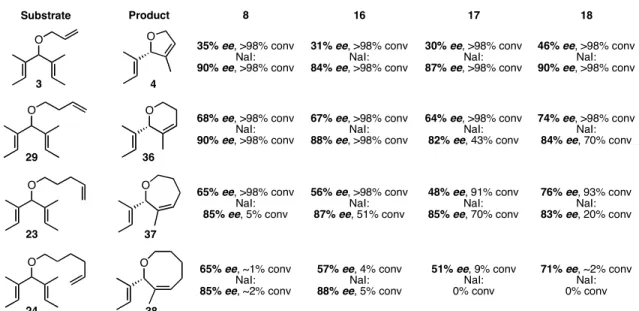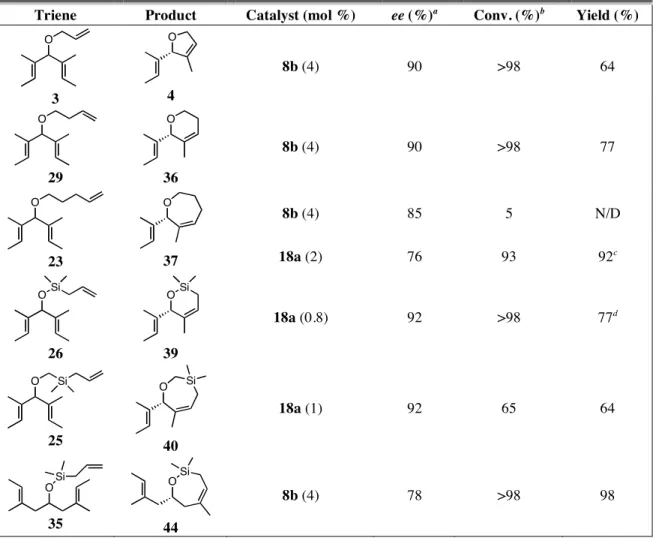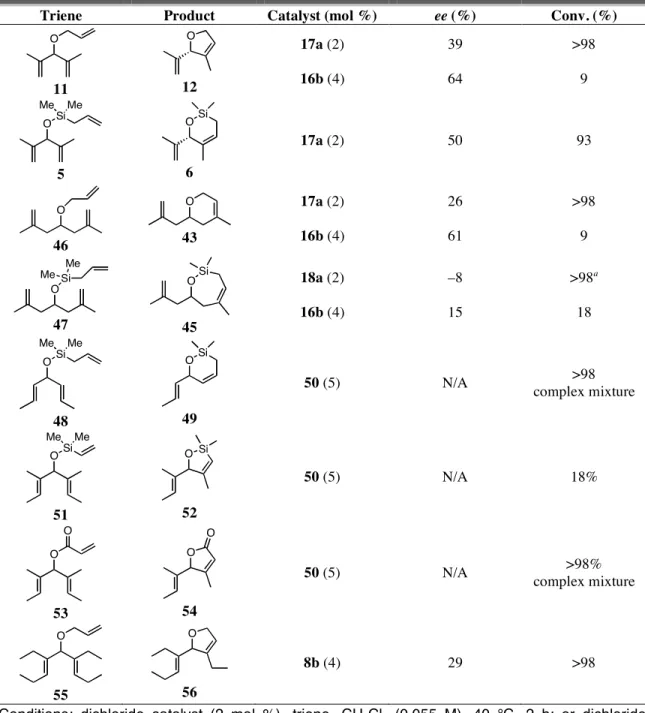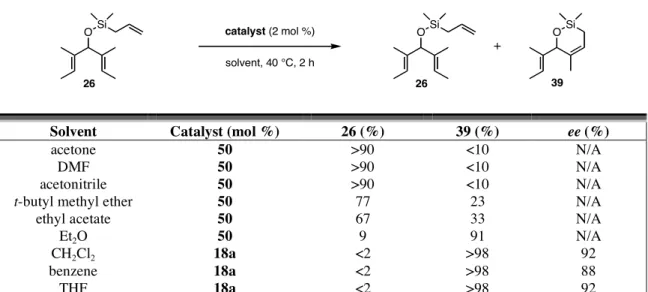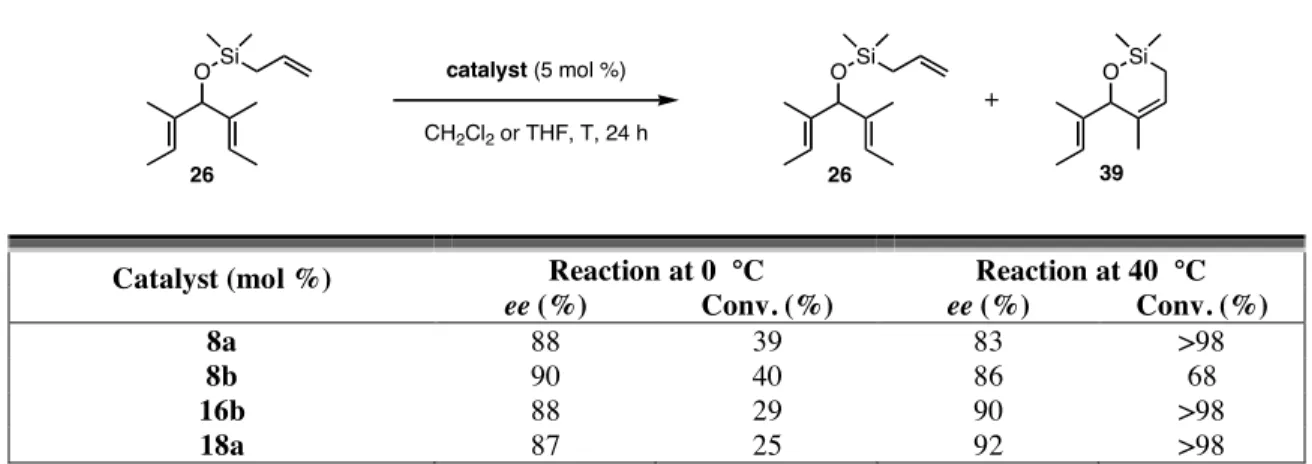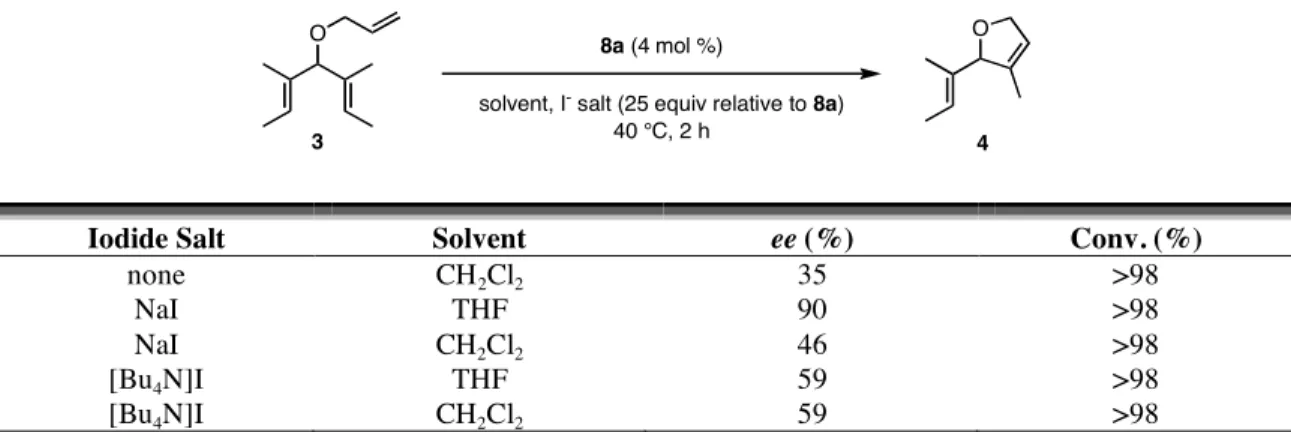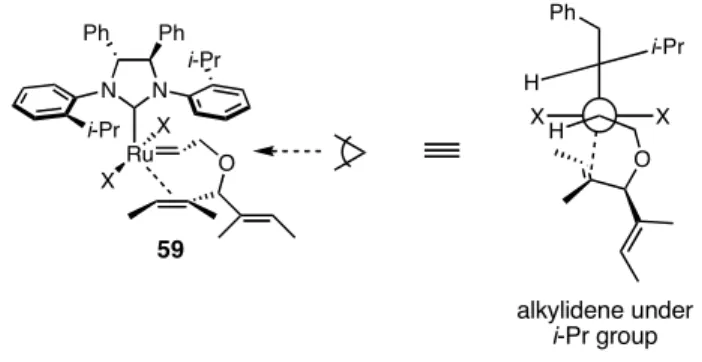60
Chapter 4
Asymmetric Ring-Closing Metathesis with Ruthenium Alkylidenes Bearing Chiral, Monodentate N-Heterocyclic Carbene Ligands
Introduction
Asymmetric olefin metathesis does not seem possible at first glance, because no sp3-hybridized carbons are formed during a metathesis reaction. Instead of creating a new sp3 carbon, asymmetric metathesis reactions form chiral compounds through either kinetic resolutions of racemates or desymmetrizations of achiral or meso compounds (Scheme 4.1). When chiral metathesis catalysts are used, enantioenriched products can be generated.1 The kinetic resolutions ideally involve selective ring closing of one enantiomer of a chiral diene while leaving the other enantiomer untouched. Asymmetric ring-closing metathesis (ARCM) and asymmetric cross-metathesis (ACM) are intramolecular and intermolecular reactions that produce a chiral center through desymmetrizations of trienes or dienes, respectively. Asymmetric ring-opening/cross metathesis (AROCM) reactions create multiple chiral centers by desymmetrizing meso compounds.
R
O kinetic resolution
R O O
R
O O
R1 R1
R1 R1 R2
R2 OR1
R2
OR1 R2 asymmetric ring-closing metathesis (ARCM)
asymmetric cross-metathesis (ACM)
asymmetric ring-opening/cross metathesis (AROCM)
Scheme 4.1. Examples of asymmetric olefin metathesis reactions.
61
Most asymmetric olefin metathesis reactions have been catalyzed by chiral molybdenum complexes, including kinetic resolutions, ARCM, AROCM, and asymmetric ring-opening/ring-closing metathesis (ARORCM).1 No single chiral molybdenum alkylidene catalyst is efficient and selective in every asymmetric metathesis reaction. Therefore, the Schrock and Hoveyda groups have generated a library of catalysts and screened them to find the best one for a given transformation. For example, complex 1 catalyzes the formation of 5-membered ring 4 with high enantioselectivity and yield, but it is inefficient and less selective in generating the six-membered ring 6 (Scheme 4.2).2 On the other hand, catalyst 2 affords 6 in 98% yield and in >99% ee, but is almost completely inactive in the synthesis of 4.3 More than 30 chiral molybdenum complexes have been made by varying the imido, alkylidene, and bidentate phenoxide groups.1b
Mo N
Ph Me Me OO
1 Me Me
Mo N
Ph Me Me
2 O O
O Ar
Ar
Ar = 2,4,6-triisopropylphenyl
OSi
SiO
O 1 or 2 (5 mol %)
benzene
O
1:6 h, 22 °C;99%ee; 83% yield 2: 18 h, 22 °C; --% ee; <5% yield
1 or 2 (5 mol %) benzene
1:24 h, 22 °C;85%ee; 20% yield 2: 3 h, 60 °C; >99% ee; 98% yield
3 4
5 6
Scheme 4.2. Differences in selectivity and efficiency between chiral molybdenum catalysts.
Much like the parent achiral molybdenum catalysts, the chiral complexes are more sensitive to air, moisture, and a variety of common functional groups than most
62
ruthenium olefin metathesis catalysts and need to be handled and stored in an inert atmosphere.1b Molybdenum olefin metathesis catalysts are incompatible with carboxylic acids, ketones, aldehydes, most alcohols, and primary amines. Because the ruthenium catalysts are so tolerant and therefore user friendly, enantioselective variants would also be expected to find widespread use. Unfortunately, only a few examples of ruthenium- catalyzed asymmetric olefin metathesis exist. Two classes of chiral ruthenium metathesis catalyst have been explored (Figure 4.1): those containing monodentate N-heterocyclic carbenes (NHCs) with chirality in the backbone developed in the Grubbs group (7 and 8)4 and those containing chiral, bidentate NHC/binaphthyl ligands developed in the Hoveyda group (9 and 10).5 Complexes 9 and 10 catalyze AROCM in up to 98% ee,6 but they exhibit reduced reactivity and selectivity toward ARCM relative to catalysts 7 and 8.7
N N
Ru O O Ph
X Ru
PCy3 N N
i-Pr
X Ph
i-Pr
X
8a (X = Cl) 8b (X = I)
Ph Ph
Ru PCy3
N N Me
X Ph Me X
7a (X = Cl) 7b (X = I)
Ph Ph
N N
Ru O O Ph
X
Ph Ph
9a (X = Cl)
9b (X = I) 10a (X = Cl) 10b (X = I)
Figure 4.1. Representative examples of chiral ruthenium olefin metathesis catalysts.
The initial study of ruthenium metathesis catalysts bearing chiral, monodentate NHCs involved screening six catalysts and three substrates.4 Complexes with NHCs derived from 1,2-diaminocyclohexane exhibited low enantioselectivities (0%–13% ee), but those derived from 1,2-diphenylethylenediamine catalyzed the formation of a 2,5- dihydrofuran in up to 90% ee. Catalyst 8b was the most selective catalyst, and the three substrates it was reacted with are shown in Scheme 4.3. The enantioselectivity of the reaction is highly dependent on the olefin substitution and the type of halide on the
63
catalyst, with iodide typically affording the highest ee. These were the only substrates explored in this study.
O O
O O
O O
catalyst (2.5–5 mol %) CH2Cl2, 38 °C
or THF, NaI, 38 °C
catalyst (2.5–5 mol %) CH2Cl2, 38 °C
or THF, NaI, 38 °C
catalyst (2.5–5 mol %) CH2Cl2, 38 °C
or THF, NaI, 38 °C
3 4
11 12
13 14
8a (2.5 mol %): 23% ee; 96% conv.
8b (5 mol %): 39% ee; 20% conv.
8a (2.5 mol %): 12% ee; 97% conv.
8b (5 mol %): 35% ee; 90% conv.
8a (2.5 mol %): 35% ee; 82% conv.
8b (5 mol %): 90% ee; 82% conv.
Scheme 4.3. ARCM of three trienes catalyzed by chiral ruthenium benzylidene complexes.
After the initial examination of catalysts 8a and 8b in ARCM, the focus shifted toward catalyzing AROCM and ACM with catalysts 8a and 8b.8 Moderate enantioselectivities (12%–82%) were observed over a wide range of substrates for both AROCM and ACM. Based on the results from the initial report,4 it was clear that the 1,2- diphenylethylenediamine-based catalysts were superior to those derived from 1,2- diaminocyclohexane. Additionally, increasing the size of the ortho substituent from methyl to isopropyl (7b to 8b) improved the enantioselectivity of the formation of 4 (85%
ee with 7b and 90% ee with 8b). Therefore, new catalysts containing varying substitution around the N-bound aryl rings that were based on 8 were targeted in this study. These substituted catalysts were tested in AROCM and ACM,8 but the results presented in this chapter are focused on ARCM with ruthenium catalysts that have substitution in the meta positions of the N-bound aryl rings. Very few substrates were tested in the initial study (Scheme 4.3), so one of the goals of the research presented here was to explore the substrate scope of this family of meta-substituted catalysts. Based on
64
the success of 8 in ARCM, it was expected that these new variants would also be selective and efficient.
Results and Discussion9
Design and Synthesis of Chiral Ruthenium Catalysts. One of the reasons the N-bound aryl rings were modified is that it was relatively straightforward to introduce structural changes to them, and therefore many different catalysts could be made. Initially, catalysts with ortho substituents larger than isopropyl were the targeted complexes.
Attempts to increase the size of the ortho substituent to t-butyl were unsuccessful.
Although a catalyst with an ortho cyclohexyl group was made, enantiomeric excesses were low (18% ee for the formation of 4), and the catalyst was unstable. It was thought that the para position was too remote from the ruthenium center, and changes there would not have any effect on the enantioselectivities. Therefore, catalysts with substitution in the meta position of the N-bound aryl rings were made.
A modular synthesis was used to access the desired chiral, non-racemic NHCs.
Most of this work was done by Jacob Berlin, another graduate student in the group, and all of the experimental details (including the synthesis of the aryl bromides) have been published.9 Briefly, these complexes were all generated by the same strategy (Scheme 4.4). Two equivalents of an aryl bromide were coupled to commercially available (1R,2R)-1,2-diphenylethylenediamine using a Pd2(dba)3/(±)-BINAP catalyst system,10 and the resulting chiral diamines were reacted with triethylorthoformate and NH4BF4 to afford dihydroimidazolium BF4
– salts. These carbene precursors were then reacted with bis- phosphine complex 15 and potassium hexafluoro-t-butoxide to generate the desired chiral
65
olefin metathesis catalysts as dichlorides. The yields for the last step varied due to a challenging chromatographic purification of the complexes. The para methoxy group in complexes 17a and 17b was used as a synthetic handle during the aryl bromide synthesis and was not expected to effect the enantioselectivities. The dichloride complexes (16a–
18a) were all stable to air and moisture for at least 6 months in the solid state, and the diiodide variants (16b–18b) were generated in situ by the addition of 25 equivalents of sodium iodide to the analogous dichloride catalyst. They were never isolated.
Br
R3 R2
R1
H2N NH2
Ph Ph
Pd2(dba)3.CHCl3 (5 mol %) (±)-BINAP (12 mol %)
NaOt-Bu, toluene 90 °C, 48 h
NH HN
Ph Ph
i-Pr i-Pr
R3
R2 R2
R1
R3 R1
NH4BF4
HCO2H HC(OEt)3 120 °C, 12 h
N N i-Pr
i-Pr
Ph Ph
R2
R2
BF4—
R1
R3
R1 R3
15 Ru PCy3
PCy3 Cl Ph
Cl
KOC(CF3)2CH3 toluene 60 °C, 6 h
Ru PCy3
N N i-Pr X Ph
i-Pr
X
Ph Ph
i-Pr
i-Pr Ru
PCy3
N N i-Pr X Ph
i-Pr
X
Ph Ph
t-Bu
t-Bu
MeO OMe
Ru PCy3
N N i-Pr X Ph
i-Pr
X
Ph Ph
i-Pr
i-Pr
16a (X = Cl) 16b (X = I) 35%–85% yield
17a (X = Cl) 17b (X = I) 35%–75% yield
18a (X = Cl) 18b (X = I) 30%–83% yield
52%–66% yield 2 steps 2 equiv
NaI (xs) NaI (xs) NaI (xs)
Scheme 4.4. Synthesis of chiral ruthenium olefin metathesis catalysts.
Substrate Synthesis. Only three substrates were used in the initial study of ruthenium catalysts bearing chiral, monodentate NHCs.4 It was discovered that one triene (3) underwent ARCM in 90% ee, but no other compounds similar to 3 were tested. One of the major goals of the research presented here was to explore the substrate scope of this family of catalysts, so the first trienes that were made were derivatives of 3. The building
66
block for all of these substrates was alcohol 21, and early on in this work 21 was made from vinyl bromide 19 (Scheme 4.5). Compound 19 was commercially available, and 21 was obtained in high yield. As more substrates were made, larger quantities of 21 were needed. Unfortunately, vinyl bromide 19 was expensive (>$2000/mol), and so an alternative route to 21 was developed. When 2-butyne (22) ($295/mol) was treated with isobutylmagnesium bromide in the presence of a catalytic amount of titanocene dichloride, a vinyl Grignard reagent was generated in situ.11 Tiglic aldehyde (20) was added to the solution, and 21 was generated. Multigram quantities of alcohol 21 were made using this procedure.
1. Cp2TiCl2 (3 mol %)
MgBr
2. O
Br 1. t-BuLi
2.
O H 20 –78 °C, Et2O
90% yield
OH
H 20 Et2O, rt 69%–86% yield
19 21
22
Scheme 4.5. Two approaches to the synthesis of alcohol 21.
With alcohol 21 in hand, many different substrates were prepared (Scheme 4.6).
Most of the alkyl ethers were made by simply generating the sodium alkoxide of 21, and reacting it with an electrophile. The low yields obtained in the synthesis of 23 and 24 were attributed to steric hindrance around the hydroxyl group in 21. Attempts to make 29 by alkylating 21 with 4-bromo-1-butene or 4-iodo-1-butene were completely unsuccessful. When the sodium alkoxide was used, elimination to form 1,3-butadiene occurred instead of the desired nucleophilic displacement. The route that finally led to 29 involved a chemoselective hydroboration with 9-BBN followed by oxidation of the alkyl borane to primary alcohol 28. The alcohol was oxidized to an aldehyde that was not
67
stable, so the crude material was subjected to a Wittig olefination to afford 29 in 29%
yield over two steps. Silyl ethers 26 and 27 were both made using standard conditions.
When electron-withdrawing groups such as allylchloroformate and vinylacetyl chloride were used as electrophiles, elimination of the carbonate or vinylacetate, respectively, occurred (Scheme 4.7).
OH
21
NaH, THF, 65–70 °C Br n = 1,3,4
Cl Si
Me Me
or
O O O O Si
3
82% yield 23
22% yield 24
44% yield 25
65% yield
ClRSiR MeOSiMe
OSi Ph Ph
26
76% yield 27
69% yield Et3N, DMAP
CH2Cl2, rt
O
3
1. 9-BBN 2. NaOH H2O2 THF, rt–50 °C 83% yield
O OH
1. (COCl)2
DMSO Et3N
CH2Cl2, –78 °C 2. [Ph3PMe]Br BuLi THF, 0 °C 29% yield over 2 steps
O
28 29
Scheme 4.6. Synthesis of ARCM substrates based on alcohol 21.
OH
21
Cl O O
pyridine, 0 °C O O
O CO2
(2 equiv)
Scheme 4.7. Elimination of a carbonate derivative of 21.
In addition to substrates based on allylic alcohol 21, trienes derived from homoallylic alcohol 33 were also made (Scheme 4.8). Compound 33 was synthesized in three steps from epichlorohydrin (30): the appropriate vinyl magnesium bromide was generated in situ,11 and in the presence of catalytic CuBr, it opened the epoxide. An
68
intramolecular nucleophilic displacement reaction transformed chlorohydrin 31 into epoxide 32, which underwent a second epoxide-opening process to afford 33. The allyl ether 34 and the dimethylallylsilyl ether 35 were formed using standard conditions, and they are analogous to compounds 3 and 26, respectively.
OH MgBr
Cp2TiCl2 (cat.)
Et2O, –40 °C 68% yield
Cl O
Cl
OH NaH
THF, reflux 51% yield
O CuBr (cat.)
33 1.
2.
MgBr Cp2TiCl2 (cat.)
Et2O, –40 °C 60% yield CuBr (cat.) 1.
2.
30 31 32
OH
33
NaH, THF, 65–70 °C 73% yield
Br
Cl Si Me Me
Et3N, DMAP CH2Cl2, rt 88% yield
O
OSi Me Me
34
35
Scheme 4.8. Synthesis of ARCM substrates based on alcohol 33.
Efficiency and Enantioselectivity of Chiral Ruthenium Catalysts. All of the achiral trienes were treated with catalysts 8, 16, 17, and 18 in the absence and presence of sodium iodide. The results of the ARCM reactions of the alkyl ethers derived from 21 are shown in Table 4.1. First, the addition of sodium iodide to the reaction had an enormous impact on the enantioselectivity, regardless of what substrate or catalyst was used. The enantiomeric excesses of the cyclic products increased up to 57% relative to those with the dichloride catalysts when the diiodide catalysts were used, and they were all >80%. Of the dichloride catalysts, 18a was the most selective for all of the substrates in Table 4.1. As the meta substituent para to the isopropyl group increased in size
69
(catalysts 8a, 16a, and 17a), the enantiomeric excess of the product decreased, but never by more than 17% when going from H to t-butyl. With the diiodide catalysts, this trend did not continue, and the selectivities were similar for 8b, 16b, and 17b.
Table 4.1. ARCM of achiral, alkenyl ethers using chiral ruthenium olefin metathesis catalysts.
O
Substrate Product
O
O O
O
16 17 18
8
O
O O
35% ee, >98% conv NaI:
90% ee, >98% conv
31% ee, >98% conv NaI:
84% ee, >98% conv
30% ee, >98% conv NaI:
87% ee, >98% conv
46% ee, >98% conv NaI:
90% ee, >98% conv
68% ee, >98% conv NaI:
90% ee, >98% conv
67% ee, >98% conv NaI:
88% ee, >98% conv
64% ee, >98% conv NaI:
82% ee, 43% conv
74% ee, >98% conv NaI:
84% ee, 70% conv
65% ee, >98% conv NaI:
85% ee, 5% conv
56% ee, >98% conv NaI:
87% ee, 51% conv
48% ee, 91% conv NaI:
85% ee, 70% conv
76% ee, 93% conv NaI:
83% ee, 20% conv
65% ee, ~1% conv NaI:
85% ee, ~2% conv
57% ee, 4% conv NaI:
88% ee, 5% conv
51% ee, 9% conv NaI:
0% conv
71% ee, ~2% conv NaI:
0% conv 3
29
23
24
4
36
37
38
Conditions: dichloride catalyst (2 mol %), triene, CH2Cl2 (0.055 M), 40 °C, 2 h; or dichloride catalyst (4 mol %), NaI (25 equiv relative to catalyst), triene, THF (0.055 M), 40 °C, 2 h.
Conversions >90% were obtained in all of the reactions with the dichloride catalysts, except when 24 was used. The product of the RCM of 24 is an eight-membered ring containing a trisubstituted alkene (38), and these types of products are typically challenging to access using RCM.12 Even though the loadings of the diiodide catalysts were doubled relative to the dichloride catalysts, lower conversions were often observed.
This may be due to catalyst decomposition, as diiodide ruthenium metathesis catalysts are typically less stable than the corresponding dichloride catalyst.13 Reactions with dichloride catalysts were performed in CH2Cl2 and reactions with diiodide catalysts were in THF, so the conversions may also be dependent on solvent.
70
The trienes derived from 21 bearing silyl alkenyl ethers were also treated with catalysts 8, 16, 17, and 18, and the results are shown in Table 4.2. For all of the substrates, the enantiomeric excess were ≥75% with the dichloride catalysts. The diiodide catalysts were typically more selective, but the differences were not nearly as large as with the substrates in Table 4.1. Additionally, as in Table 4.1, selectivity decreased as steric bulk in the meta position increased (8a, 16a, and 17a), but there was no simple trend with the analogous diiodide catalysts.
Table 4.2. ARCM of achiral, silyl alkenyl ethers using chiral ruthenium olefin metathesis catalysts.
Substrate Product OSi
OSi
O Si O Si
16 17 18
8 83% ee, >98% conv
NaI:
86% ee, 68% conv
81% ee, >98% conv NaI:
90% ee, >98% conv
75% ee, >98% conv NaI:
85% ee, >98% conv
92% ee, >98% conv NaI:
92% ee, 58% conv
84% ee, 88% conv NaI:
87% ee, 15% conv
80% ee, 91% conv NaI:
90% ee, 75% conv
78% ee, 90% conv NaI:
86% ee, 50% conv
92% ee, 93% conv NaI:
92% ee, 10% conv
OSi Ph Ph
OSi
Ph Ph
77% ee, >98% conv NaI:
83% ee, 96% conv N/D N/D 80% ee, >98% conv
NaI:
N/D 26
25
27
39
40
41
Conditions: dichloride catalyst (2 mol %), triene, CH2Cl2 (0.055 M), 40 °C, 2 h; or dichloride catalyst (4 mol %), NaI (25 equiv relative to catalyst), triene, THF (0.055 M), 40 °C, 2 h. N/D = not determined.
The most exciting discovery was that 18a catalyzed the ARCM of 26 and 25 in 92% ee. Not only was this the highest enantiomeric excess obtained using this family of catalysts, but also it was achieved without the need for sodium iodide. Moreover, since the dichloride catalysts are generally more stable than the diiodide catalysts, lower catalyst loadings could be used. No difference in enantioselectivity and a decrease in conversion was observed when 18b was reacted with 26 and 25. It was thought that the success of these substrates was due in part to the methyl groups on the dimethylsilyl
71
linker increasing the difference in energies of the diastereomeric transition states, so a triene with two phenyl groups (27) was made. Unfortunately, the enantioselectivity of the reactions with 27 were lower than with 26 and 25.
In addition to the substrates based on allylic alcohol 21, the trienes derived from 33 were also reacted with 8, 16, 17, and 18 (Table 4.3). When both 34 and 35 underwent ARCM, small amounts of the products lacking a terminal methyl group (43 and 45) were formed. The enantiomeric excesses of the methylated and demethylated products were generally similar, suggesting the methyl group was removed after the ring closing occurred. The matched or mismatched interaction of the catalysts with the chiral products could explain the increase or decrease in enantiomeric excess of the demethylated products relative to the methylated products observed in some cases (compare 44 and 45 with catalyst 16b). The reactions with allyl ether 34 went to complete conversion with all of the catalysts, but the reactions were only moderately selective (up to 58% ee). Greater enantioselectivities were obtained with silyl ether 35, but reactions with the analogous substrates based on alcohol 21 (Table 4.2) were more selective under these conditions.
72 Table 4.3. ARCM of substrates derived from alcohol 33.
Substrate Product
O Si
OSi
16 17 18
8
OSi 35
O
O
O 29%ee, <5% conv NaI:
38%ee, <5% conv
35%ee, <5% conv NaI:
54%ee, <5% conv
28%ee, <5% conv NaI:
47%ee, <5% conv 31%ee, >95% conv
NaI:
35%ee, >95% conv
37%ee, >95% conv NaI:
58%ee, >95% conv
23%ee, >95% conv NaI:
44%ee, >95% conv
31%ee, >95% conv NaI:
N/D
13%ee, >95% conv NaI:
N/D
32%ee, 9% conv NaI:
61%ee, <5% conv
27%ee, 20% conv NaI:
35%ee, 8 conv 56%ee, 91% conv
NaI:
78%ee, >95% conv
39%ee, 80% conv NaI:
74%ee, 92% conv
36%ee, 95% conv NaI:
51%ee, 89% conv
30%ee, 5% conv NaI:
22%ee, 11% conv
52%ee, >98% conv NaI:
77%ee, >98% conv
6%ee, <2% conv NaI:
not observed 34
42
43
44
45
Conditions: dichloride catalyst (2 mol %), triene, CH2Cl2 (0.055 M), 40 °C, 2 h; or dichloride catalyst (4 mol %), NaI (25 equiv relative to catalyst), triene, THF (0.055 M), 40 °C, 2 h. N/D = not determined.
The data in Tables 4.1 and 4.2 showed that the addition of meta substituents para to the ortho isopropyl group (catalysts 16 and 17) only caused minor fluctuations in the enantioselectivity of the reaction. The introduction of a meta isopropyl group ortho to the ortho isopropyl group (18) increased the selectivity of the catalyst. From these reactions it became clear that the parent complex 8b, and the diisopropyl variant 18a, were the most selective catalysts of those tested. Therefore, isolated yields were obtained from ARCM reactions between 8b or 18a and selected achiral trienes (Table 4.4). The yields for 4 and 36 were moderately reduced due to the volatility of the products during purification. Attempts to use less than 4 mol % of 8b resulted in incomplete conversion of 3 to 4. When a more challenging substrate (23) was used, 8b formed the product in 85% ee, but in only 5% conversion. Catalyst 18a is much more efficient (presumably because it is more stable that 8b),13 and 37 was isolated in 92% yield and 76% ee.14
73
Compound 39 was isolated in 77% yield using almost 1 g of 26 with less than 1 mol % of 18a, and no decrease in enantiomeric excess occurred relative to the screening reactions.
Table 4.4. ARCM reactions of selected achiral trienes with chiral ruthenium catalysts.
Triene Product Catalyst (mol %) ee (%)a Conv. (%)b Yield (%)
O
3
O
4
8b (4) 90 >98 64
O
29
O
36
8b (4) 90 >98 77
8b (4) 85 5 N/D
O
23
O
37 18a (2) 76 93 92c
OSi
26
OSi
39
18a (0.8) 92 >98 77d
O Si
25
O Si
40
18a (1) 92 65 64
OSi
35
OSi
44
8b (4) 78 >98 98
Conditions for reactions with 8b: NaI (25 equiv relative to catalyst) and 8a in THF (0.055 M in triene) for 1 h at rt, then add triene and stir for 2 h at 40 °C; conditions for reactions with 18a:
triene, CH2Cl2 (0.055 M in triene), and 18a for 2 h at 40 °C. a Enantiomeric excesses determined by chiral GC. b Determined by 1H NMR spectrum of crude reaction mixture. c See reference 14.
d Reaction done on a 4 mmol (0.95 g) of 26 scale. N/D = not determined.
All of the achiral trienes described above have two trisubstituted olefins with cis methyl groups. These substrates were used because, in the initial study with catalyst 8, compounds with no terminal methyl groups (11, Scheme 4.3) or with trans methyl groups (13, Scheme 4.3) underwent ARCM with low enantioselectivity. Many other substrates
74
were screened with the chiral ruthenium metathesis catalysts to determine if the substrate scope was general or limited, and the best results are shown in Table 4.5.
Table 4.5. Best results of ARCM reactions with “other” achiral trienes.
Triene Product Catalyst (mol %) ee (%) Conv. (%)
O
11
O
12
17a (2) 16b (4)
39 64
>98 9
OSi Me Me
5
OSi
6
17a (2) 50 93
O
46
O
43
17a (2) 16b (4)
26 61
>98 9
OSi Me Me
47
OSi
45
18a (2) 16b (4)
–8 15
>98a 18
OSi Me Me
48
OSi
49
50 (5) N/A >98
complex mixture
OSi Me Me
51
O Si
52
50 (5) N/A 18%
O O
53
O O
54
50 (5) N/A >98%
complex mixture
O
55
O
56
8b (4) 29 >98
Conditions: dichloride catalyst (2 mol %), triene, CH2Cl2 (0.055 M), 40 °C, 2 h; or dichloride catalyst (4 mol %), NaI (25 equiv relative to catalyst), triene, THF (0.055 M), 40 °C, 2 h. a See appendix 1 for information on an interesting side product. Catalyst 50 = (H2IMes)RuCl2(=CHPh).
N/A = not applicable.
75
The meta substituted catalysts (16 and 17) were more selective than 8 in reactions with 11, but 12 was formed in either poor ee and excellent conversion or moderate ee and poor conversion. Compound 5, which is analogous to the excellent substrate 26, was only formed in 50% ee. Just as in the reactions with substrates 11 and 5, trienes 46 and 47 did not undergo ARCM as selectively and efficiently as the analogous compounds with cis methyl groups.15 The lower conversions obtained using diiodide catalysts with 11, 46, and 47 may be due to the formation of a ruthenium methylidene instead of an ethylidene that would be generated with 3, 34, and 35. Ruthenium methylidenes are known to decompose more rapidly than other alkylidenes, and in these cases decomposition may have occurred more quickly than the cross-metathesis reaction that introduced the triene to the catalyst.16
Substrates other than those lacking terminal methyl groups were also explored.
The RCM of 48 with the achiral catalyst 50 ((H2IMes)RuCl2(=CHPh)) afforded a mixture of volatile products, but no starting material remained; secondary metathesis with the acyclic olefin in 49 likely occurred. Vinylsilanes typically cause decomposition of ruthenium metathesis catalysts,17 so it was not surprising that very low yields of 52 were obtained when 51 was reacted with 50. Acrylate 53 reacted with catalyst 50, but a mixture of unidentified products were formed. Finally, because only trienes with cis methyl groups underwent ARCM in high enantioselectivities, substrate 55 was made to test if groups larger than methyl would work. The product (56) was formed in only 29%
ee. It was clear from these data that chiral catalysts 8, 16, 17, and 18 were only highly selective with a small set of substrates.
76
The conditions used in the ARCM reactions discussed above were very similar to the optimized conditions used in the initial report,4 so various factors were reexamined to attempt to improve yields and enantiomeric excesses. A solvent screen was performed first (Table 4.6). Reactions performed in acetone, N,N-dimethylformamide (DMF), and acetonitrile afforded the product in <10% yield. Ethyl acetate and MTBE were better solvents, but the yields were still low. The best solvents were methylene chloride, benzene, and THF, where 39 was formed in >98%. The enantioselectivity was not affected when THF was used in place of CH2Cl2, and the slight reduction in benzene suggests that solvent coordination to the catalyst is not as important as in the molybdenum systems.18
Table 4.6. Solvent screen.
OSi
catalyst (2 mol %) solvent, 40 °C, 2 h
OSi OSi
26 26 39
Solvent Catalyst (mol %) 26 (%) 39 (%) ee (%)
acetone 50 >90 <10 N/A
DMF 50 >90 <10 N/A
acetonitrile 50 >90 <10 N/A
t-butyl methyl ether 50 77 23 N/A
ethyl acetate 50 67 33 N/A
Et2O 50 9 91 N/A
CH2Cl2 18a <2 >98 92
benzene 18a <2 >98 88
THF 18a <2 >98 92
N/A = not applicable.
Another variable that was adjusted was the reaction temperature; it was lowered to 0 °C, and the conversions and enantioselectivities of the ARCM of 26 were explored (Table 4.7). When catalysts 8a and 8b were used, the enantioselectivities increased relative to the reactions at 40 °C. On the other hand, the enantioselectivities decreased
77
when ARCM reactions with 16b and 18a were done. The highest conversion of 26 at 0 °C was 40%, and in all cases the reactions were allowed to proceed for 24 h with 5 mol
% of catalyst. It was suspected that catalyst initiation (phosphine dissociation) was slow at 0 °C, so acid was added in an attempt to increase the rate of initiation.19 Unfortunately, no 39 was formed upon addition of either 1 equivalent of HCl in diethyl ether or 20 equivalents of benzoic acid relative to the catalyst. Although in some reactions a small increase in enantioselectivity was observed, this approach was not practical because the conversions were low.
Table 4.7. ARCM reactions at 0 °C.
OSi
catalyst (5 mol %) CH2Cl2 or THF, T, 24 h
OSi OSi
26 26 39
Reaction at 0 °C Reaction at 40 °C Catalyst (mol %)
ee (%) Conv. (%) ee (%) Conv. (%)
8a 88 39 83 >98
8b 90 40 86 68
16b 88 29 90 >98
18a 87 25 92 >98
The last variable that was explored was a combination of the iodide source and the solvent in reactions with diiodide catalysts. The original protocol called for sodium iodide in THF,4 but reactions with the dichloride catalysts were done in CH2Cl2, so sodium iodide and tetrabutylammonium iodide were tested in THF and CH2Cl2 (Table 4.8). By far the most selective combination is sodium iodide in THF. When sodium iodide in CH2Cl2 is used in place of THF, the enantioselectivity suffers drastically, although it is not as low as the reaction with just 8a and no sodium iodide (35% ee). This could be due to the insolubility of sodium iodide in CH2Cl2. After 1 h in THF, the
78
sodium iodide/8a mixture dissolved completely (by visual inspection), but a white solid remained in CH2Cl2. The enantioselectivity also decreased when the iodide source was changed to tetrabutylammonium iodide, but it remained higher than the reaction without any iodide. The [Bu4N]I never completely dissolved in THF, but it appeared to be completely soluble in CH2Cl2. In both reactions 4 was formed in 59% ee. One explanation for the success of the NaI/THF combination is that NaI is soluble in THF but NaCl is not; so the equilibrium between I-bound and Cl-bound ruthenium is forced to generate only the ruthenium diiodide catalyst.
Table 4.8. Effects of iodide source and solvent in ARCM.
O 8a (4 mol %)
solvent, I- salt (25 equiv relative to 8a) 40 °C, 2 h
O
3 4
Iodide Salt Solvent ee (%) Conv. (%)
none CH2Cl2 35 >98
NaI THF 90 >98
NaI CH2Cl2 46 >98
[Bu4N]I THF 59 >98
[Bu4N]I CH2Cl2 59 >98
Absolute Stereochemistry Proof. All four chiral ruthenium catalysts tested in this study (8, 16, 17, and 18) afforded the same enantiomer of the product for any given substrate in Tables 4.1–4.4, and the absolute stereochemistry of a few of the products was determined (Scheme 4.9). The absolute stereochemistry of 12-ent was proven by an independent synthesis using a Sharpless kinetic resolution.2 Compound 12-ent was also made with chiral molybdenum catalysts, and a GC trace using a Chiraldex GTA column was used to determine the enantioselectivities of the reactions. The chiral ruthenium complex 8a catalyzed the formation of 12, which was also separated on a Chiraldex GTA column.
79
The GC traces showed that chiral catalyst 8a, and therefore all the catalysts used in this study, afforded 12 in the absolute configuration shown in Scheme 4.9 and Table 4.5. The absolute configuration of 4 was determined by exposing it to ethenolysis conditions, which generated the same enantiomer of 12 that was obtained by the ARCM reaction of 11. Finally, compound 39 was oxidized to diol 57 and exposed to a one-pot mesylation/intramolecular nucleophilic displacement sequence to afford the same enantiomer of 4 that was obtained by the ARCM of 3. Chiral, cyclic products derived from a triene lacking terminal methyl groups (11), containing cis methyl groups and an alkenyl ether (3), and containing cis methyl groups and a dimethylsilyl alkenyl ether (26) all had the same absolute stereochemistry, which suggests that all of the products synthesized with 8, 16, 17, or 18 have the same absolute configurations.
O
Ru PCy3
N N
Cl Ph Cl 2 mol %
CH2Cl2, 40 °C, 2 h Ph Ph
i-Pr
i-Pr Me
Me
MeO OMe
4 35% ee
50 (5 mol %) 60 psi ethylene
CH2Cl2, 40 °C
16 h 12
33% ee
O 8a 2 mol %
CH2Cl2, 40 °C, 2 h
Same GC trace Chiral GTA column O
12 39% ee 11
O O
3
O
12-ent ref. 2 Chiral GTA column
OSi
26
16a (3 mol %) NaI, THF, 40 °C, 2 h
OSi
39 87% ee
MsCl (1 equiv) Et3N CH2Cl2 rt, 15 min KF
KHCO3 H2O2 MeOH/THF
(1:1) rt, 16 h
OH OH O
4 86% ee 57
Same GC trace Chiral GTA column
Scheme 4.9. Absolute stereochemistry proof.
80
Model to Rationalize Enantioselectivity of Chiral Ruthenium Catalysts. An understanding of how and why catalysts 8, 16, 17, and 18 induce asymmetry in the RCM of achiral trienes would allow for the rational design of new, more selective catalysts.
Therefore, a model to explain the experimental observations was developed. First, it was suspected that the ARCM reactions were irreversible, so enantioenriched 39 was treated with achiral catalyst 50 under the same conditions used in the ARCM reactions. No erosion in the enantiomeric excess of 39 was detected. Additional support for the irreversibility of ARCM came from the fact that essentially no loss in enantiomeric excess was observed when 4 was reacted with ethylene and achiral catalyst 50 under forcing conditions (Scheme 4.10).
50 (5 mol %) 60 psi ethylene
CH2Cl2 40 °C, 16 h
O
35% ee4 83% unreacted O
35% ee4
O
12 33% ee 17% conv.
Scheme 4.10. Ethenolysis of 4.
Chapters 2 and 3 of this dissertation describe how the achiral variant (50) of the chiral catalysts used here does not readily react with 1,1-disubstituted and trisubstituted alkenes. Therefore, all of the ARCM reactions are thought to proceed through a ruthenium alkylidene derived from the monosubstituted olefin present in every substrate.
This species binds one of the diastereotopic alkenes and, through a metallacyclobutane intermediate/transition state, forms the ring-closed product.
Olefin coordination to the ruthenium is an important, stereodefining step;
unfortunately, the actual position where the olefin binds relative to the NHC is unclear.
There is experimental evidence to support coordination both cis and trans to the NHC.20 If coordination is cis, than the alkene should bind to the catalyst face opposite the
81
isopropyl group to avoid an interaction with it (Scheme 4.11, 61).4 Either olefin could coordinate cis to the NHC, but structure 61 has the non-binding alkene in the more stable, pseudoequatorial position of the cyclic intermediate. Additionally, a hydrogen instead of a vinyl group is directed toward a halide. Completion of the ARCM reaction from 61 affords the major enantiomer.
Ru N N
i-Pr
X X
Ph Ph
i-Pr
O Ru
N N
i-Pr
X X Ph Ph
i-Pr
O trans olefin binding pathway
Ru N N
i-Pr X
Ph Ph
i-Pr
O X
Ru N N
i-Pr X
Ph Ph
i-Pr
X O H
cis olefin binding pathway
O
4 Ru
N N
i-Pr X
Ph Ph
i-Pr
O
O
4-ent
major enantiomer minor enantiomer
Ru N N
i-Pr
Ph Ph
i-Pr
X X O X
60 61
58 59
Scheme 4.11. Proposed pathways leading to the desired product.
Recent experimental reports suggest the alkene may be coordinating trans to the NHC,20b,c and computational studies also support trans binding.21 One computational study explored the energetics of 8b reacting with 3, and the most favored pathway is depicted in Scheme 4.11 (trans olefin binding pathway).21a The steric interaction that favors 59 over 58 is between the substituents on the alkylidene and the N-bound aryl ring.
82
The calculations concluded that the aryl ring is not orthogonal to the plane of the NHC (90°), but is instead tilted 75°. X-ray crystallographic analysis of a derivative of 7a provided experimental evidence to support the calculations.4 In this model, the side of the aryl ring with an isopropyl group was found to be smaller than the side with no substitution, so the larger alkylidene substituent (the ether) was positioned under the isopropyl group (Figure 4.2). Just as in 61, the non-coordinating vinyl group is in the pseudoequatorial position in 59.
Ru N N
i-Pr
X X Ph Ph
i-Pr
O
i-Pr
H Ph
O
alkylidene under i-Pr group
X X
H
59
Figure 4.2. Suggested alkylidene position in trans olefin binding pathway.
Although the discussion presented here focuses on a substrate that forms a five- membered ring, the ideas could be extended to trienes that form other ring sizes. For a given substrate, there is presumably an energetically favored ring conformation that occurs once the olefin is coordinated to the ruthenium center. By adding substitution to the ring, the difference in energies of the cyclic, olefin-bound intermediates/transition states may increase, and the reaction may be more selective. That is a possible explanation as to why the reactions with the dimethylsilyl-containing trienes were more enantioselective than the reactions with substrates containing only alkyl ethers.
In almost every reaction shown in Tables 4.1–4.3, the addition of sodium iodide increased the enantioselectivity. One explanation for this effect is based on steric interactions: in the cis olefin binding pathway of Scheme 4.11, either a hydrogen (as
83
shown in 61) or a vinyl group could be directed at the halide trans to the NHC. If the vinyl group was directed at the halide, the minor enantiomer would be formed. As the size of the halide is increased from chloride to iodide, the strength of the interaction between the two groups is be expected to increase, and the structure with a hydrogen in that position is expected to be lower in energy. In the trans olefin binding pathway, calculations suggest that as the halides increase in size, they are pushed away from each other and toward the alkylidene. That would put them in closer proximity to the reacting olefin, creating a smaller binding pocket, and therefore a more selective reaction.21a
Another explanation for the large iodide effect is based on electronic factors. It is known that phosphine dissociation occurs more quickly for the diiodide variant of achiral catalyst 50 than for 50-dichloride, but the reactivities of the active species are similar.13b Phosphine dissociation is the rate-limiting step in catalyst initiation, so the fact that 50- diiodide initiates quickly but does not increase the rate of product formation suggests that the active species derived from 50-diiodide is less active than that derived from 50- dichloride. Based on these data, it is reasonable to assume that the active species of the chiral diiodide catalysts are less active than the dichloride active species. When a highly active catalyst with an alkylidene derived from one of the achiral trienes discussed above is used, the rate- and enantio-determining step might be olefin binding. Therefore, metathesis would occur regardless of which diastereotopic alkene initially coordinated to the ruthenium center. On the other hand, a less-active catalyst may coordinate the olefin but not perform the ring-closing reaction. Instead, the olefin could dissociate and re-bind, setting up a rapid equilibrium. In this case ruthenacyclobutane formation, not olefin binding, would be the rate- and enantio-determining step, regardless of which conformer

